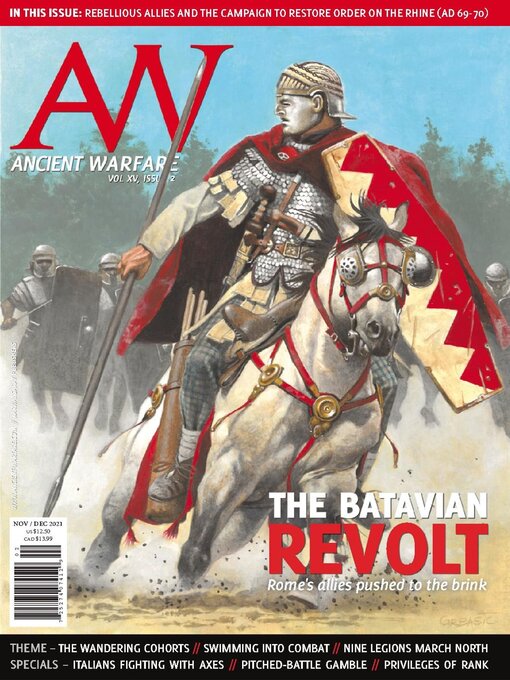Ancient Warfare is a unique publication focused exclusively on soldiers, battles, and tactics, all before 600 AD. Starting with ancient Egypt and Persia and continuing to the fall of the Western Roman Empire, Ancient Warfare examines the military history of cultures throughout Europe, the Middle East and parts of Asia and Africa. Ancient Greece and Rome receive the most frequent coverage, due both to the wealth of contemporary sources and the modern fascination with these two great civilizations. Subject-matter ranges from the familiar to the more obscure: while Alexander the Great, the Persian Wars and Caesar’s Gallic campaigns all receive regular coverage, Ancient Warfare also looks at some of the less common parts of ancient military history, from chariots as battle taxis to PTSD in antiquity.
Ancient Warfare Magazine
EDITORIAL
PRELIMINARIES
TALES OF THE AXE • In Virgil’s Aeneid, Camilla, queen of the Volsci, charges into her last battle with one breast bared like an Amazon. A peerless bellatrix (warrior woman), she slays ten Trojan and Etruscan heroes with lance, javelin, or bow, but when she encounters Orsilochus, the tallest of the Trojans, she grabs a valida securis, a mighty axe. She hacks through Orsilochus’ armour and smashes his arm bones. Ignoring Orsilochus’ pitiful pleas for mercy, Camilla splits his skull and hot brains run down his face.
BURIED IN A BROTHER’S ARMS • In June 1818, an English architect on his Grand Tour was riding in Greece near the town of Chaeronea. His horse tripped on the sculptural remains of a large lion. This was the funerary sculpture, the Lion of Chaeronea, grave marker of the final stand of the Theban Heiros Lochos, the Sacred Band. The monument was mentioned by Pausanias (9.4.10) and the find offered corroboration of one of the most remarkable units in the history of Greek warfare. When excavated, the grave revealed 254 skeletons laid out side by side in seven rows.
THE BATAVIAN REVOLT • The demise of Nero in AD 68 had set the stage for four claimants – Galba, Otho, Vitellius, and Vespasian – to make their bid for the purple. This period, characterized by Tacitus (Histories I.2) as “rich in disasters, terrible with battles, torn by civil struggles and horrible even in peace”, also saw longstanding allies turn against Rome, provinces break away to germinate a Gallic empire, and Rome’s own legions murder their leaders and defect to the enemy. Order was finally restored by a general campaigning with the largest number of legions under one commander in Roman history.
SHAMEFUL BEHAVIOUR • Martial rape is a topic which pervades all genres of ancient literature, both Greek and Roman alike. It starts with Briseis, Achilles’ war prize and concubine, but anyone familiar with Greek tragedy or a Roman comedy likely has come across war captives, plunder, abduction and sexual assault in the aftermath of combat. Despite its prevalence, martial rape is a topic which has been neglected by modern scholars, especially where Rome is concerned.
TACITUS’ STEREOTYPES • To call the Roman historian Tacitus (ca. AD 55-ca. AD 120) a conservative senator would be a pleonasm. Roman senators and Latin authors often held conservative views. The early Roman Republic had been wonderful, they believed, with virtuous heroes conquering the world, but after some time, the masters of the Mediterranean had become accustomed to luxury. Wealth had created avarice, moral standards had collapsed, and in the present age, Rome was as corrupt as it was powerful. This ‘present age’ was flexible, contemporary with the author.
NO BARRIER TO BATTLE • In AD 69, on the shores of the River Po in northern Italy, troops from Germania Inferior clashed with an army fighting for the newly appointed Emperor Otho. Eight Batavian cohorts marched with Caecina. The battle was fought across a river, but this proved no barrier to the...

 AW XVIII.4
AW XVIII.4
 AW XVIII.3
AW XVIII.3
 AW XVIII.2
AW XVIII.2
 AW XVIII.1
AW XVIII.1
 AW XVII.6
AW XVII.6
 AW XVII.5
AW XVII.5
 AW XVII.4
AW XVII.4
 AW XVII.3
AW XVII.3
 AW XVII.2
AW XVII.2
 AW XVII.1
AW XVII.1
 AW XVI.6
AW XVI.6
 AW XVI.5
AW XVI.5
 AW XVI.4
AW XVI.4
 AW XVI.3
AW XVI.3
 AW XVI.2
AW XVI.2
 AW XVI.1
AW XVI.1
 AW XV.6
AW XV.6